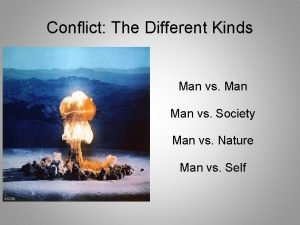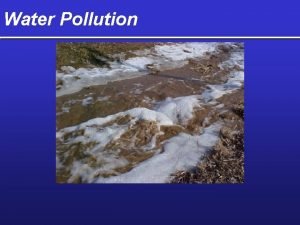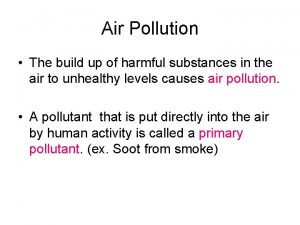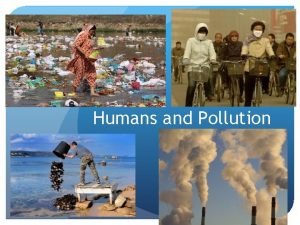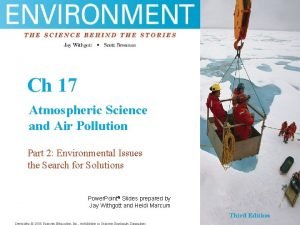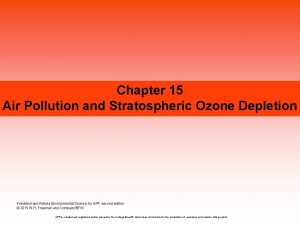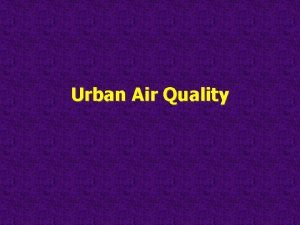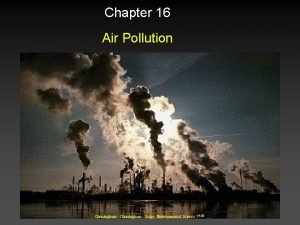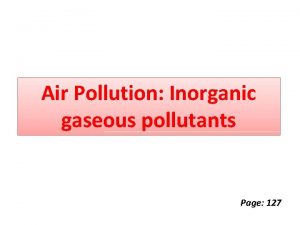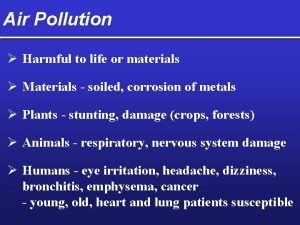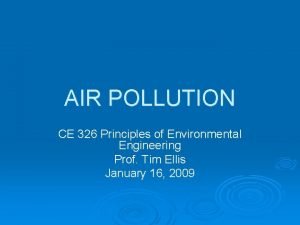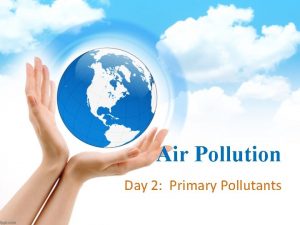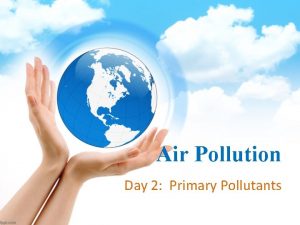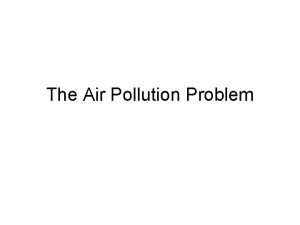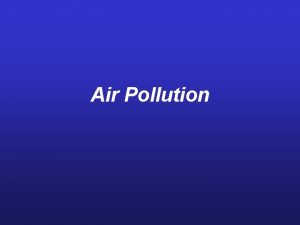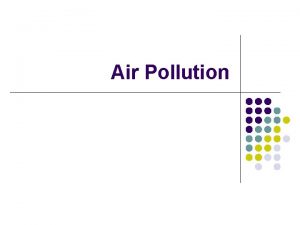Humans and Pollution Man Pollutants and pollution Pollutants











- Slides: 11

Humans and Pollution Man…

Pollutants and pollution � Pollutants are released by human activities � As human population increases so does the effect of pollution � Matter (gas, liquid or solid) that is both organic or inorganic � Energy in the form of sound, light or heat � Living organisms such as invasive species and biological agents � Primary pollutants � Active on emission and can kill immediately (ex: carbon monoxide) � Secondary pollutants � Formed by primary pollutants that undergo chemical or physical change

Major Sources of Pollution Major Source Pollutant Effect Combustion of fossil fuels Carbon dioxide Climate change Sulfur dioxide Acid rain Nitrogen oxides Respiratory and eye irritation Photochemical smog Secondary pollutant causing respiratory and eye irritation Carbon monoxide Blocks hemoglobin - death Organic waste (food and sewage) Eutrophication and waterborne disease Waste paper Fills landfills Plastics Fills landfills, ocean pollution Glass Some recycled but most goes to landfill Tins/cans Can be recycled but most goes to landfill Domestic waste

Major sources of pollution Major Source Pollutant Effect Industrial waste Heavy metals Poisoning Fluorides Poisoning Heat Reduces solubility of gases in water – less oxygen Lead Disabilities in children Acids Corrosive Nitrates Eutrophication Organic waste Eutrophication Pesticides Accumulate up the food chain Agricultural Waste

Pollutants Point Source Non-Point Source �Clearly identifiable source � Release from numerous dispersed sites � Example is car exhaust � Many sources � Hard to determine direct cause � Pollution found in rivers, lakes and oceans traveled far from the source � One solution is to cap pollution from all possible sources � Example is a factory dumping waste �Easy to manage – stop pollution at the source

Persistent organic pollutants �Old pesticides that remain active in the environment for long periods of time �Bioaccumulation in the food chain �Example: �DDT – best pesticide of all time…. weakened egg shells leading to the near extinction of birds of prey

Rise and Fall of DDT Conflict

Types of Pollution Acute Chronic �Large amounts of pollution are released at one time causing immediate harm �Small amounts of pollution released over a long period of time � Ex: Bhopal Disaster � Often goes undetected � Difficult to determine source and difficult to clean up � Widespread � Ex: air pollution

Detection and Monitoring of Pollution Direct measurement Indirect measurement �Acidity of rainwater �Amount of gas in the atmosphere �Amount of particulates emitted by an engine �Amount of lead �Measure abiotic factors that change when exposed to a pollutant � Oxygen in a lake that has fertilizer run-off �Trent biotic index � Look at the types animals – some thrive in polluted environments whereas others don’t � Frogs don’t do pollution

Pollution Management Process of Pollution Level of Pollution Management Human activity producing the pollution Change the human activity that is producing the pollution • Campaigns • Education • Community groups • Legislation • Economic incentives Release of the pollution into the environment Control the location of the release and the amount • Legislate and regulate emission • Develop standards/apply technologies to extract pollutants from emission Impact of pollutants on the environment Clean up and restore damaged ecosystem • Remove pollutant • Replenish/restock/replant lost species

Story time with Hank 10 most polluted cities in the world
 Man vs. society
Man vs. society Planting more trees is called
Planting more trees is called Primary pollutants and secondary pollutants
Primary pollutants and secondary pollutants What are the secondary air pollutants
What are the secondary air pollutants What is secondary pollutant
What is secondary pollutant Ozone layer depletion
Ozone layer depletion Primary and secondary pollutants difference
Primary and secondary pollutants difference Secondary pollutants examples
Secondary pollutants examples Primary vs secondary pollutants
Primary vs secondary pollutants Inorganic gaseous pollutants of air
Inorganic gaseous pollutants of air Secondary air pollutants
Secondary air pollutants Primary vs secondary pollutants
Primary vs secondary pollutants
